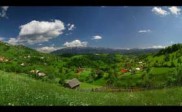Dealing with Light and Composition in Landscape Photography
For those attracted to majestic and dramatic natural sceneries, or to everything full of color, landscape photography can be their haven. Landscape photography offers a huge span of interpretations and possibilities. There are many factors which affect how a landscape is rendered in a photograph. The most important ones are the time of the year and the time of the day in which the photo was taken, the weather at the moment of the capture and composition. However, it’s also easy to take a dull and boring landscape photo. How many times did you stop in awe in front of a beautiful scenery, took out your camera , took some shots and then were deceived by the results you got ? While everything seems perfect in reality (beautiful light, breathtaking view ….) the photos you get sometimes aren’t what you expect. This is usually caused by neglecting some rules and techniques related to landscape photography and which can help you get amazing photographs.

landscape photos by Yassine Hakimi
Equipment and camera Settings for landscape photography:
First things first, let’s get the equipment issue out of the way. You can get great landscape photos with whatever camera you have got. What matters is your talent in composition and in choosing the best time to shoot. But, there is always gear which can make it easier for you to produce beautiful pictures. So, when shooting landscape, it’s better to opt for a wide angle lens in order to be able to capture huge sceneries. This is not a rule, though. You can use a telephoto lens and still get amazing landscapes. Also consider using a tripod to set the camera. It can be very useful in low light situation and it will guarantee you sharp photos. Also, consider getting some filters like a polarizing filter for reflective surfaces and a graduated ND filter for landscapes with a tricky lighting. As for the camera, you would be ideally using a camera which allows you to control aperture, shutter speed and ISO. When setting the camera, choose low ISO values, to avoid any kind of noise and set a small aperture (f/8 or f/11) to get a wide depth of field. Shutter speed will be determined by the aperture, the ISO and the amount of light in the scene.
The hardest part about landscape photography is that you need to transcribe a multisensory experience (scents, wind, textures, etc) into a visual medium. This is where the talent of the landscape photographer appears. So, if you want to create beautiful landscape photos forget about your equipment and concentrate on what’s essential: light, atmosphere and composition.
Light & Atmosphere:
In order to get beautiful landscapes, you should try to capture the atmosphere which characterizes the scenery. Try to choose the moment when the light seems to produce the emotion you felt when you first saw the landscape. Don’t hesitate to visit the place you are photographing at different times of the day and to choose the most appropriate moment. Some landscape photographers wait, several days before taking a photo. You also need to be sensitive to the atmosphere and to what’s happening around you. Observe the different colors and try to compare how they appear under different light conditions. Sunset light, for instance, will give you warm tones and soft details. On the other hand, midday light will produce tones that are colder and the contrast of the image will be harsher, try to avoid this kind of light and try shooting instead early in the morning or near sunset. When considering the best moment to photograph a landscape, think of the scenery as a huge still life image which needs lighting that will help details, textures and patterns stand out. For such an effect you need light which is at the level of your subject which in the case of landscape is the sunset and sunrise light. The sun is still low in the sky and will provide you with lighting which will give you what you need.
Weather:
The scattered leaves of autumn, the rain falling from a stormy sky, the dark clouds passing through blue sky, the powerful lightning cutting its way through the clouds, or the surprising appearance of a rainbow, all these weather elements can make your landscape photos jaw dropping. In landscape photography you have to learn how to give life to the scenery in front of you, and the weather conditions are your best ally for creating such an effect. Bad weather can be bad for traffic, but for a landscape photographer, it can present boundless opportunities of great photographs. So, don’t just go out to shoot landscape when the sky is clear and the weather is cool. Take advantage of the different seasons of the year and go out shooting even if it’s freezing. Since the sky takes usually a big part of a landscape composition, it’s always better to capture it at its best, and, that’s not necessarily on a hot summer day. It will be most probably moments before or moments after a storm. That’s when the sky will unleash its full potential in front of your lens.
Composition:
Composition is all about arranging the different elements within the frame, in a way that will please the eye. The best thing about landscape photography is that you can take your time to study the scenery, to find the best point of view and to choose which element to include in your composition. Still, it’s not always easy to find the perfect point of view, as it may change depending on the light and weather conditions, discussed above. So, when you set out to photograph a landscape, try first to move around and experiment with different angles before taking the shot. Don’t try to take a photo that includes everything in front of you. Be selective, and find something that would work as a main element of the composition. It can be a pattern, a color, an object. Anything goes, as long as it will make the photo different from a snapshot. Once, you locate your main composition element, it’s time to concentrate on the other things in your frame. Here are some tips to help you while composing your shot:
– Use the rule of thirds: The rule of thirds works perfectly for landscape photos. Try to always place your horizon line in either the top or bottom thirds of the frame and avoid placing it in the centre of the photo. You can determine where to place it depending on the importance you want to give to either the sky or the ground.
-Don’t forget to make sure your horizon line is perfectly straight, or the photo won’t have an impact on the viewer and will look like a normal snapshot. You can be sure you got the horizon line straight by using the gridlines present on most of the digital cameras, or by using a tripod which has an indicator to make the photo level.
– Inspect the borders of the frame: Before pressing the shutter release button, examine the borders of the frame, especially the bottom one and make sure nothing disturbs your composition. The tiniest intruding object can ruin a beautiful image.
Here some examples of inspiring landscape photography:

Photo by Porfolio

Photo by PJFB – Photography

Photo by REMY SAGLIER – DOUBLERAY

Photo by Tonyç

Photo by Garry

Photo by James Jordan

Photo by Dene

Photo by Gigi 62
You may want to take a look at Common Landscape Photography Mistakes



